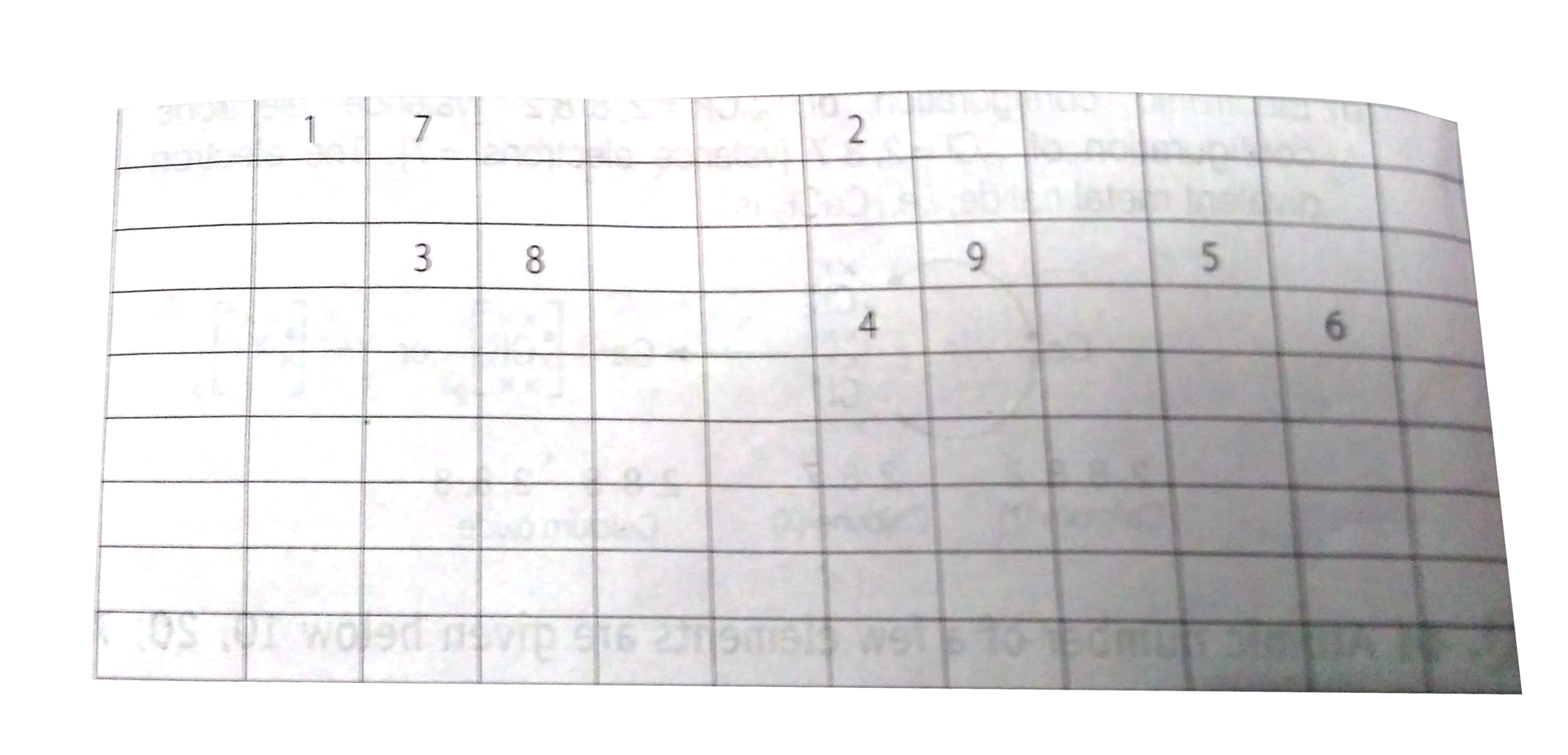Below are some elements of modern periodic table
4Be,9F,14Si,19K,20Ca
Identify the element that belong to halogen family
To identify the element that belongs to the halogen family from the given list of elements, we can follow these steps:
1. Understand the Halogen Family: The halogen family consists of elements that are found in Group 17 of the periodic table. These elements typically have 7 valence electrons.
2. List the Given Elements: The elements provided are:
- Beryllium (Be) with atomic number 4
- Fluorine (F) with atomic number 9
- Silicon (Si) with atomic number 14
- Potassium (K) with atomic number 19
- Calcium (Ca) with atomic number 20
3. Determine the Electronic Configurations:
- Beryllium (Be): Atomic number 4 → Electronic configuration: 2, 2 (2 valence electrons)
- Fluorine (F): Atomic number 9 → Electronic configuration: 2, 7 (7 valence electrons)
- Silicon (Si): Atomic number 14 → Electronic configuration: 2, 8, 4 (4 valence electrons)
- Potassium (K): Atomic number 19 → Electronic configuration: 2, 8, 8, 1 (1 valence electron)
- Calcium (Ca): Atomic number 20 → Electronic configuration: 2, 8, 8, 2 (2 valence electrons)
4. Identify the Element with 7 Valence Electrons: From the electronic configurations, we see:
- Be has 2 valence electrons
- F has 7 valence electrons
- Si has 4 valence electrons
- K has 1 valence electron
- Ca has 2 valence electrons
5. Conclusion: Since Fluorine (F) has 7 valence electrons, it belongs to the halogen family.
Final Answer:
The element that belongs to the halogen family is Fluorine (F).
---
- Beryllium (Be) with atomic number 4
- Fluorine (F) with atomic number 9
- Silicon (Si) with atomic number 14
- Potassium (K) with atomic number 19
- Calcium (Ca) with atomic number 20
- Beryllium (Be): Atomic number 4 → Electronic configuration: 2, 2 (2 valence electrons)
- Fluorine (F): Atomic number 9 → Electronic configuration: 2, 7 (7 valence electrons)
- Silicon (Si): Atomic number 14 → Electronic configuration: 2, 8, 4 (4 valence electrons)
- Potassium (K): Atomic number 19 → Electronic configuration: 2, 8, 8, 1 (1 valence electron)
- Calcium (Ca): Atomic number 20 → Electronic configuration: 2, 8, 8, 2 (2 valence electrons)
- Be has 2 valence electrons
- F has 7 valence electrons
- Si has 4 valence electrons
- K has 1 valence electron
- Ca has 2 valence electrons
The element that belongs to the halogen family is Fluorine (F).
Topper's Solved these Questions
- THE PERIODIC TABLE BOOK - ICSECHAPTER - THE PERIODIC TABLE EXERCISE - TOPIC 2 Studying Individual Groups (3 Marks Questions)
25 Videos
- THE PERIODIC TABLE BOOK - ICSECHAPTER - THE PERIODIC TABLE EXERCISE - TOPIC 2 Studying Individual Groups (5 Marks Questions)
34 Videos
- THE PERIODIC TABLE BOOK - ICSECHAPTER - THE PERIODIC TABLE EXERCISE - TOPIC 2 Studying Individual Groups (1 Mark Questions)
15 Videos
- THE LANGUAGE OF CHEMISTRYBOOK - ICSECHAPTER - THE LANGUAGE OF CHEMISTRYEXERCISE - EXCERCISE 1(C ) (Correct the following statement)
21 Videos
- WATERBOOK - ICSECHAPTER - WATEREXERCISE - TOPIC 2 Solution (5 MARKS QUESTIONS)
5 Videos
Similar Questions
Knowledge Check
Given below are the names of few elements based on their position in the periodic table. Identify the element which is not correctly placed.
AAn element which tends to lose three electrons-AluminiumBAn element which tends to gain two electrons-lodineCAn element with valency four-SiliconDA transuranium element-plutonium
Below are some elements of modern periodic table
4Be,9F,14Si,19K,20Ca
Select the element which has one electron in its outermost shell
View SolutionName or state with reference to the elements of the modern periodic table.
The period and group to which the element 'X' with electronic configuration 2, 8, 8, 2 belongs.
View SolutionComplete the following crossword puzzle (Figure)
Across
(1) An element with atomic number 12
(3) Metal used in making cans and member of group 14
(4) A lustrous non-metal which has 7 electrons in its outermost shell
Down
(2) Highly reactive and soft metal which imparts yellow colour when subjected to flame and is kept in kerosene
(5) The first element of second period
(6) An element whihc is used in making flurescent bulbs and is second member of group 18 in the modern periodic table
(7) A radioactive element which is the last member of halogen family
(8) Metal which is an important constituent of steel and forms rust when exposed to moist air
(9) The first metalloid in modern periodic table whose fibres are used in making bullet-proof vests

View SolutionName or state with reference to the elements of the modern periodic table.
The element, from the elements Li, Na, K, having the least number of electron shells.
View SolutionName or state with reference to the elements of the modern periodic table.
The element from the elements C, O, N, F, having the maximum nuclear charge.
View SolutionName or state with reference to the elements of the modern periodic table.
The element from the elements Li, Na, K which has maximum metallic character.
View Solution(a) How is the valency of an element determined if its electronic configuration is known? Determine the valency of an element of atomic no. 9
(b) Given below are some elements of the Modern Periodic Table. Atomic numbers of the elements are given in the parentheses:
A(4), B(9), C(14), D(19), E(20)
(i) With the help of the electronic configuration, find out which one of the above elements will have one electron in its outermost shell?
(ii) Which rwo elements belong to the same group? Give reasons for your answer.
(iii) Which one of the above elements belonging to the fourth period has bigger atomic radius and why?.
View Solution
